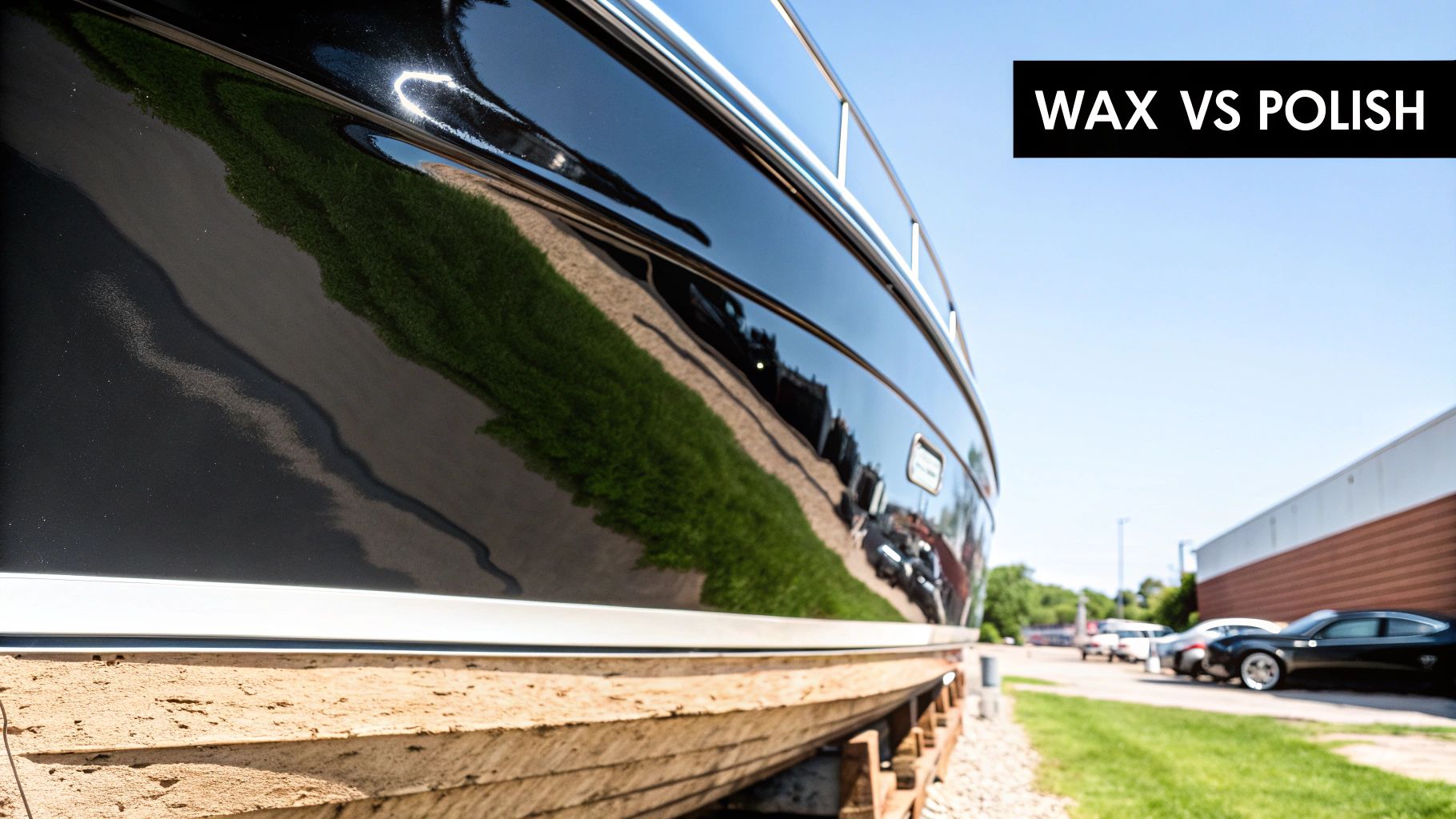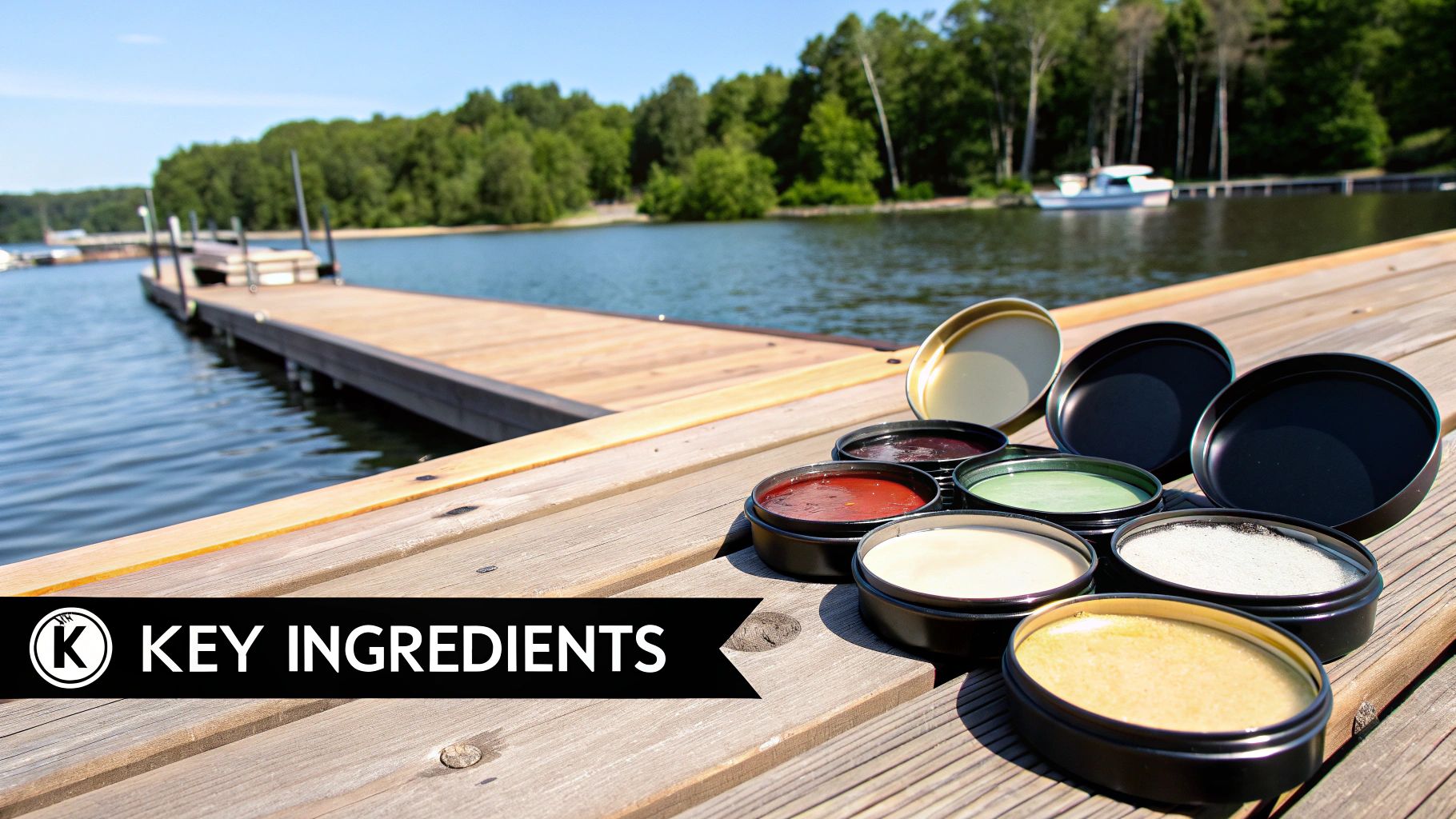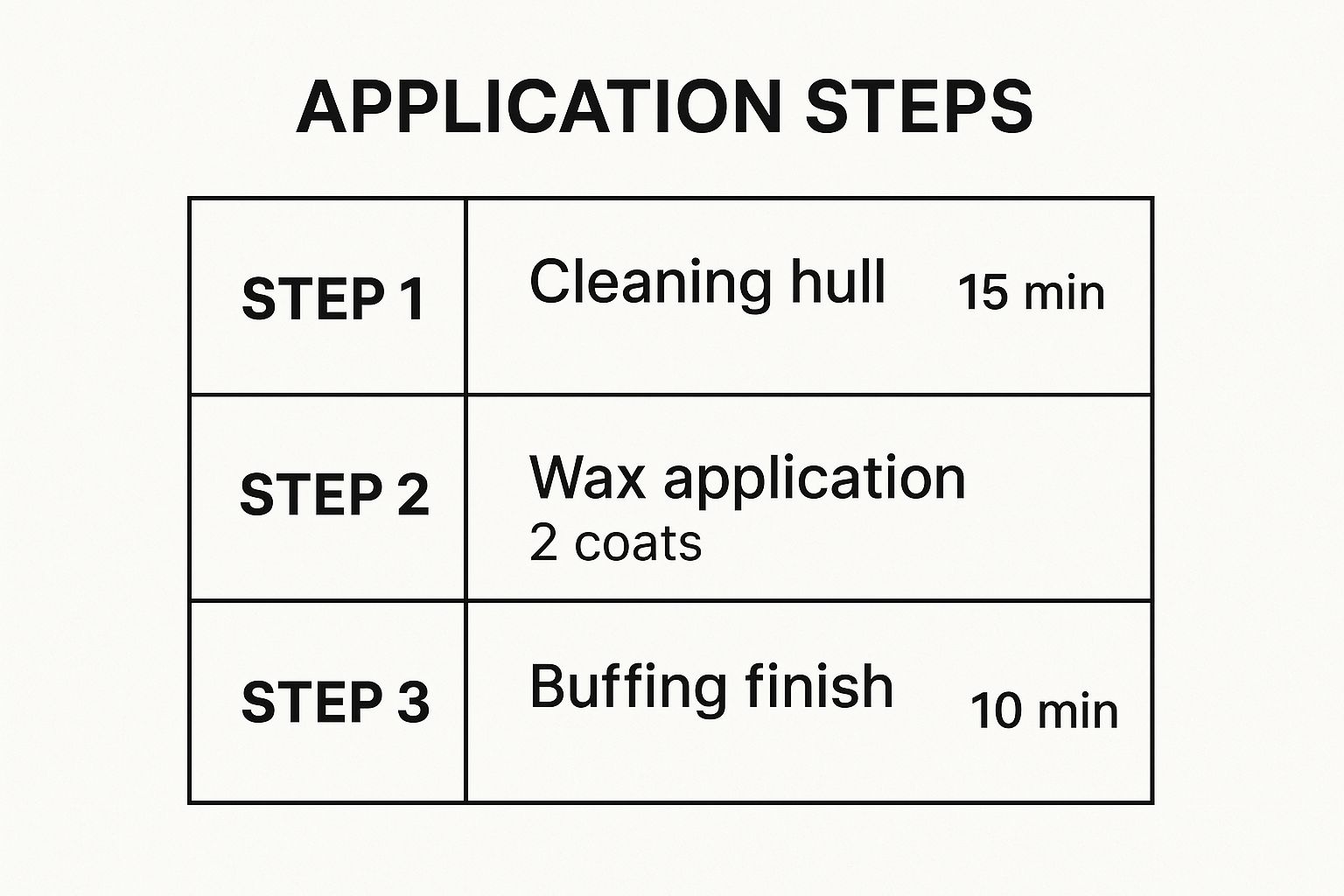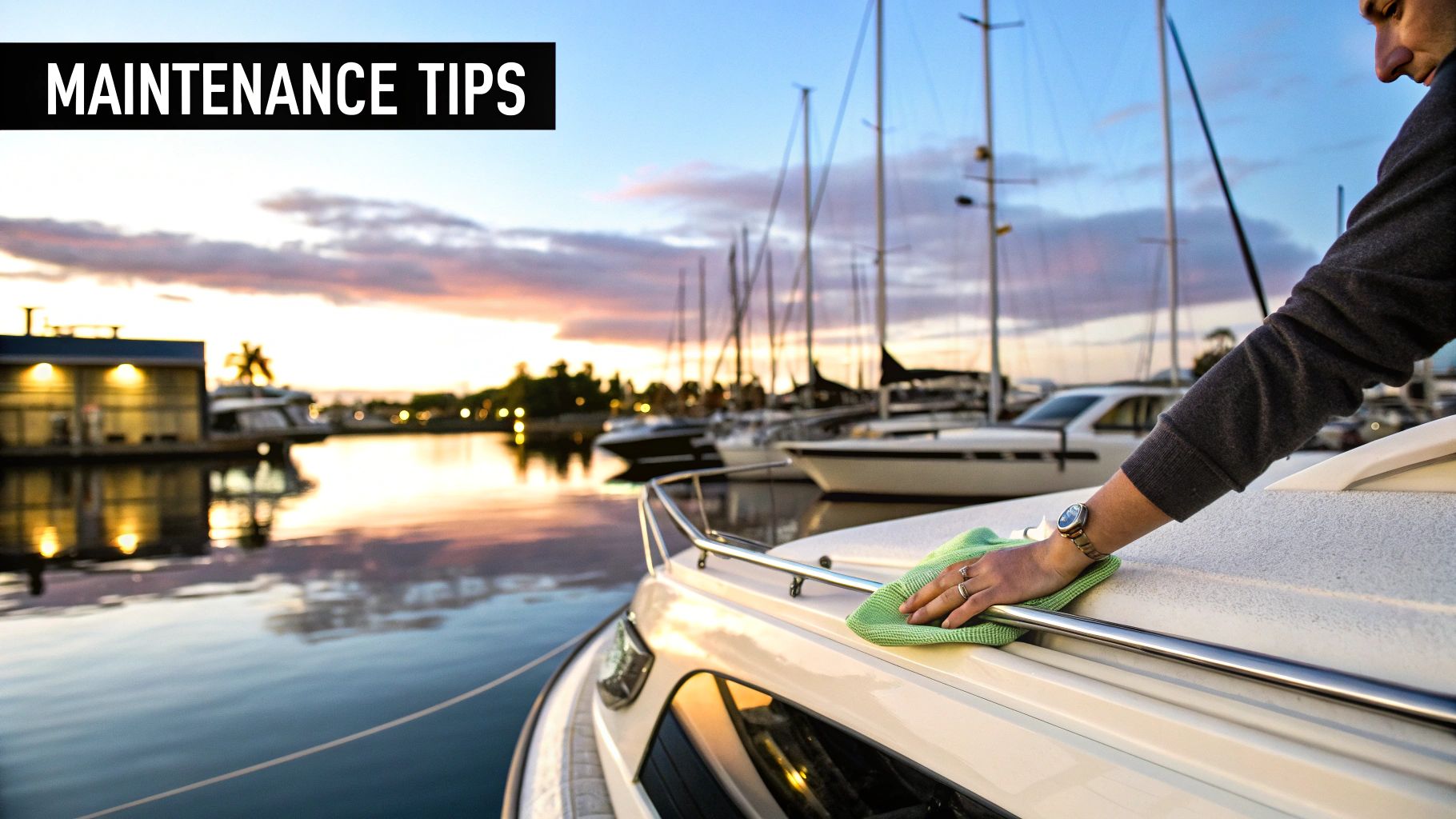Choosing the Best Boat Wax and Polish for a Lasting Shine
Picking out the best boat wax and polish isn't just about grabbing any bottle off the shelf. For real, lasting protection, you're usually looking at a high-performance marine paste wax paired with a fine-grit polish to bring back that showroom shine. A killer combination, like a tough polymer sealant with a carnauba wax topcoat, gives you a serious shield against UV rays and saltwater while laying down a deep, glossy finish that’ll turn heads at the dock.
Why Your Boat Deserves More Than Just a Rinse

A quick hose-down might get the salt off, but it does next to nothing to protect your boat’s gelcoat from its biggest enemies. It helps to think of your boat's finish not as a simple layer of paint, but as a protective skin that's constantly under attack from the sun, salt, and water. Without a real barrier, that skin starts to break down, leading to expensive repairs and a boat that just looks tired.
This is where a solid wax and polish routine becomes so important. It’s not just about looking good; it's fundamental to preserving your boat's integrity and value. Think of it as preventative maintenance that shields your investment from the very elements that are trying to tear it down.
Understanding the Threats to Your Hull
Your boat’s gelcoat is surprisingly porous, which makes it an easy target for a few key culprits. If you don't stay on top of it, the damage can become permanent over time.
- UV Radiation: The sun is absolutely relentless. Its rays beat down on your boat, causing the gelcoat to fade, weaken, and get brittle. This is what causes that chalky, dull look we all know as oxidation.
- Saltwater Corrosion: When saltwater evaporates, it leaves behind tiny salt crystals. These crystals act like little magnifying glasses, amplifying the sun's rays and speeding up UV damage. On top of that, the salt itself chemically eats away at the finish, creating microscopic pits that become magnets for dirt and grime.
- Oxidation: This is basically the slow "rusting" of your gelcoat. As it reacts with oxygen and UV light, the surface gets dull, faded, and rough. It doesn't just look bad; it loses its ability to protect the fiberglass underneath.
Protecting your boat isn’t just about making it shiny; it’s a crucial part of your maintenance schedule. A well-protected hull is way easier to clean, resists staining, and holds a significantly higher resale value.
The boating world has definitely caught on. The global boat polish market hit an estimated value of $500 million in 2025 and is only expected to keep growing. You can dig into more of the data on boat polish market trends if you're curious. That kind of growth just goes to show how many owners are realizing that proper surface care is non-negotiable.
Polish vs. Wax: Understanding the Critical Difference

It’s one of the most common mix-ups in boat care: using the terms ‘polish’ and ‘wax’ as if they’re interchangeable. In reality, they do two completely different—and equally vital—jobs for your boat’s hull. Getting this straight is the absolute first step to achieving that deep, professional shine you’re after.
If you get them backward, you're in for a lot of wasted time and some seriously disappointing results. You might end up trying to protect a surface that's still dull and oxidized, which just doesn't work.
Polish Restores, Wax Protects
Think of boat polish as the restorer. Its entire purpose is corrective. Polish is loaded with mild abrasives that are designed to gently buff away all the junk that ruins your finish—the chalky haze of oxidation, fine scratches, and those stubborn water spots that just won’t wash off. It literally smooths out the surface, bringing the color back to life and getting it ready for that final protective coat.
On the flip side, boat wax is the protector. Once the polish has done the hard work of restoring the surface, wax comes in to seal the deal. It creates a tough, sacrificial barrier that stands between your beautifully restored gelcoat and the brutal marine environment. This is the shield that defends against damaging UV rays, saltwater corrosion, and everyday grime, which also makes your next wash-down a heck of a lot easier.
A Simple Way to Think About It
Let's make this crystal clear with an analogy from daily life: skincare.
Polishing your boat is like exfoliating your skin. It sloughs off the dull, dead layer to reveal the fresh, healthy surface underneath. Waxing is the high-SPF sunscreen you apply right after. You’d never put on sunscreen before you exfoliate, right? And you definitely wouldn't leave freshly exfoliated skin to bake in the sun without protection.
The sequence is non-negotiable for the best results: polish first, then wax. Trying to wax a dull, unpolished hull is like painting over a dirty wall—you're just sealing in all the imperfections.
This two-step process is the foundation of proper boat detailing. One product corrects, the other protects. Once you get that simple concept down, you'll know how to use the right products in the right order for a flawless shine that actually lasts.
For a deeper dive into the hands-on process, check out our complete guide on how to properly wax your boat to really master the technique.
How to Select the Right Product for Your Boat
Walking into the marine supply store and seeing a wall of waxes and polishes can be pretty overwhelming. So, where do you start? The trick is to tune out the marketing noise and focus on two things: your boat's current condition and its material.
Think of it this way: a boat with a chalky, oxidized hull needs some serious TLC first. That means you're looking for a "restorative" product—a polish or a compound with light abrasives designed to strip away that dead, faded layer. On the other hand, if your boat's finish is already in decent shape, you're in "protection" mode. Your goal is simply to find a durable wax or sealant to keep it looking good.
This simple workflow breaks down the job into three clear stages.

As you can see, the actual waxing part is relatively quick. The real work is in the prep—getting the surface clean and ready is more than half the battle.
Match the Product to Your Boat's Surface
The single most important factor is what your boat is made of. A product formulated for a fiberglass gelcoat might do nothing—or worse, cause damage—if you slap it on a painted aluminum hull or a wooden deck. The vast majority of modern boats have a fiberglass hull with a gelcoat finish, which is a porous resin that needs products designed specifically for it.
One of the biggest mistakes we see is boaters using automotive wax on their vessel. Car wax is designed for a car’s clear coat, not gelcoat. It just doesn’t have the heavy-duty UV blockers and tough polymers needed to survive the relentless assault of sun, salt, and water.
For fiberglass, a high-quality marine wax is non-negotiable. Formulas from brands like Collinite or Meguiar's are engineered to bond with gelcoat and provide a tough, protective barrier. To really dive deep into what works, check out our guide on the best boat wax for fiberglass to help you choose with confidence.
Comparison of Marine Wax and Polish Types
To make sense of the different bottles on the shelf, it helps to understand what each type of product is actually designed to do. Some are for heavy-duty restoration, while others are purely for protection and shine. This table breaks down the main categories.
| Product Type | Primary Use | Key Benefit | Best For |
|---|---|---|---|
| Rubbing Compound | Heavy oxidation removal | Restores chalky, neglected surfaces | Severely faded or oxidized gelcoat |
| Polish | Light oxidation & swirl removal | Refines the surface for a high-gloss finish | Hulls with minor fading or swirl marks |
| Cleaner Wax | Light cleaning & protection | One-step solution for cleaning and waxing | Boats in good condition needing a quick touch-up |
| Carnauba Paste Wax | Long-term protection & deep gloss | Unmatched depth of shine and durability | Creating a show-quality, wet-look finish |
| Polymer Sealant | Synthetic protection | Long-lasting, slick, and easy to apply | Boaters wanting maximum durability with less effort |
| Hybrid Ceramic Wax | Cutting-edge protection & water beading | Creates a hydrophobic, mirror-like barrier | Maximum protection against the elements and easy cleaning |
Choosing the right one comes down to an honest assessment of your boat's condition. You wouldn't use a heavy-duty compound on a new boat, and a simple cleaner wax won't do much for a hull that's been ignored for five years. Start with the right tool for the job.
Evaluate Key Performance Factors
Once you know the type of product you need, you can compare specific brands and formulas by looking at a few key features:
- UV Protection: This is the big one. Your boat is constantly bombarded by the sun, and UV rays are what break down gelcoat and cause it to oxidize. Make sure the label explicitly mentions UV inhibitors or UV blockers.
- Durability: How long will your hard work last? As a rule of thumb, paste waxes offer the longest-lasting shield, often protecting your hull for up to a full season. Liquid waxes are quicker to apply but will likely need a refresh every few months.
- Finish Type: What kind of shine are you after? Carnauba-based waxes are legendary for producing a deep, rich, wet-look gloss. Synthetic polymer sealants, on the other hand, tend to create a sharper, almost glass-like reflection.
In the end, it's not complicated. Just ask yourself three questions: What's my boat made of? What condition is the finish in? And what do I want it to look like? Answering those will point you to the perfect product every single time.
Comparing Formulations: Paste, Liquid, and Spray

Picking the right boat wax isn't just about the brand on the label. The form it comes in—paste, liquid, or spray—makes a huge difference in how you'll apply it and what kind of results you can expect.
Think of it like choosing a tool from your toolbox. You wouldn't use a sledgehammer for a finishing nail, right? Each one has its place. Similarly, each wax formulation is built for a specific job, offering its own unique mix of durability, shine, and ease of use. The trick is matching the right one to your boat's needs and how much time you have.
Paste Wax: The Heavy-Duty Protector
Paste wax is the old-school champion of boat protection, and for good reason. It’s packed with a high concentration of waxes like carnauba, which creates an incredibly tough, long-lasting barrier against the elements. Its thick consistency does a fantastic job of filling in the microscopic pores in your gelcoat, giving you a deep, wet-look shine that’s tough to beat.
But all that protection comes at a price: sweat. Applying paste wax is a workout. It takes some serious elbow grease to spread it evenly and buff it off. Because of the effort involved, it’s the go-to choice for that big, once-or-twice-a-year waxing job where maximum, long-haul protection is your number one goal.
Liquid Wax: The Versatile All-Rounder
Liquid wax is the perfect middle ground, giving you a great balance of protection and user-friendliness. It’s way easier to work with than paste, spreading quickly and buffing out to a brilliant shine with much less effort. This makes it perfect for applying by hand or with a machine polisher.
While it might not have the same staying power as a top-shelf paste wax, a quality liquid formula still delivers excellent UV protection and a fantastic gloss. It’s become a favorite for regular maintenance for boat owners who want great results without dedicating an entire weekend to the job. It’s effective, efficient, and keeps your boat looking sharp all season.
Pro Tip: For the ultimate finish, a lot of pros use a layering technique. They'll start with a durable polymer sealant (usually a liquid) as a base coat, then top it with a high-quality carnauba paste wax. The sealant provides the long-lasting foundation, and the paste wax adds that extra depth and show-stopping gloss.
This best-of-both-worlds approach is why the market is so balanced. In fact, while liquid and spray waxes make up about 55% of sales due to their convenience, paste waxes still hold a strong 40% share for those heavy-duty jobs. It’s worth the effort—a well-kept boat can command a resale price 15-20% higher than a neglected one. You can dig into more of the numbers on the boat polish market segmentation.
Spray Wax: The Quick Refresher
Spray wax is all about speed and convenience. It’s the fastest, easiest way to give your boat a quick shine and a light layer of protection. Think of it as a touch-up tool, perfect for using right after a wash to eliminate water spots and boost the existing coat of wax on your hull.
It definitely offers the least durability of the three, but it's an indispensable product for keeping that "just-waxed" look going between your major detailing sessions. It’s not meant to be your primary line of defense, but rather a maintenance product to keep your hull slick, glossy, and shielded from the sun with minimal effort.
A Step-by-Step Guide to a Professional Finish
Getting that coveted showroom shine isn't about some secret formula—it's about following a methodical process. Even the absolute best boat wax and polish will look terrible if you slap it on the wrong way. A proven technique is your ticket to a durable, swirl-free finish that protects your investment and looks incredible. The name of the game is patience and attention to detail.
Before you even think about popping the top on a bottle of wax, the surface has to be perfectly, undeniably clean. Wash the boat from top to bottom with a quality marine soap to get rid of all the salt, dirt, and general grime. After a good rinse, dry the hull completely with clean microfiber towels. Any lingering moisture will just get in the way of the wax and mess up the application.
Proper Application Technique
Whether you’re working by hand or with a machine polisher, the core principles are the same. Your goal is simple: apply a thin, even coat of product without messing up the gelcoat. Rushing this stage is easily the most common mistake boat owners make.
If you're going the old-school route by hand, grab a soft foam or microfiber applicator pad. For machine application, an orbital buffer is your best friend. Its random motion is key to preventing the nasty swirl marks that rotary buffers can leave if you’re not careful. Always use a clean, soft foam pad designed for applying wax, not a coarse compounding pad.
- Work in Small Sections: Don't try to be a hero and wax the entire boat at once. Focus on a manageable 2x2 or 3x3 foot area at a time. This gives you enough time to apply and remove the wax before it dries too hard and becomes a nightmare to buff off.
- Apply a Thin, Even Coat: More is definitely not better here. A thick coat of wax is just wasteful, a pain to remove, and doesn't add any extra protection. Squeeze a small amount of product onto your pad and spread it over the section using overlapping circular or straight-line motions.
- Allow It to Haze: This step is crucial, so don't skip it. Let the wax dry to a light haze. How long this takes depends on the product, temperature, and humidity, but you're usually looking at about 5-10 minutes. You can check it by swiping a finger across the surface—if it smears, it needs more time. If it wipes clean, you're good to go.
- Buff to a Shine: Using a clean, dry microfiber towel, gently buff off the wax residue. Keep flipping the towel to a clean side so you’re actually removing the dried wax, not just pushing it around.
The most common application error is applying too much pressure, especially with a buffer. Let the tool and the product do the work. Leaning into it with excessive force is a fast track to creating swirl marks and an uneven finish, undoing all your hard prep work.
Avoiding Common Mistakes
Getting pro-level results is just as much about knowing what not to do. So many boaters sabotage their own efforts with a few simple, avoidable mistakes. A little bit of knowledge goes a long way, and you can dive deeper into the nuances of choosing the right products by exploring the key differences between marine wax and polish in detail.
Make sure you steer clear of these common pitfalls:
- Working in Direct Sunlight: A hot surface will cause the wax to dry almost instantly. This makes it nearly impossible to apply evenly or buff off cleanly. Do yourself a favor and work in the shade or on a nice overcast day.
- Using Dirty Applicators or Towels: Any speck of grit or old product residue on your pads or towels will be ground right into your finish, causing fine scratches. Always, always start with fresh, clean materials.
- Skipping the Prep Work: Trying to wax over an oxidized or dirty surface just seals all those imperfections in. Proper cleaning and, if necessary, polishing is completely non-negotiable for a lasting, high-gloss finish.
The Shift Toward Eco-Friendly Marine Care
As boat owners, we're not just enjoying the water; we're its frontline stewards. That responsibility is driving a huge shift in the marine care industry, moving us away from old-school formulas and toward products that protect both our investment and the delicate ecosystems we float on. Let's face it, many traditional waxes and polishes are loaded with harsh chemicals and petroleum distillates that aquatic life just can't handle.
When those compounds wash off your hull—whether from a good cleaning or just from being in the water—they introduce pollutants that can be toxic to fish, plants, and everything in between. This growing awareness is completely changing how we think about the best boat wax and polish, placing a new, much-needed premium on sustainability.
What to Look for in Green Formulations
Responding to our demand, the top brands are now rolling out advanced, eco-friendly products that give you that incredible shine without the ecological guilt. These newer formulas are often biodegradable and have low VOCs (Volatile Organic Compounds), which are nasty chemicals that evaporate and pollute the air.
When you're scanning a product label, keep an eye out for these key terms:
- Biodegradable: This is the big one. It means the ingredients can be broken down naturally by microorganisms, not linger in the water forever.
- Water-Based: These formulas ditch the harsh petroleum solvents in favor of water, making them much gentler on the environment.
- Low-VOC: Products with low or zero VOCs are better for the air we breathe and are a whole lot safer for you to handle during application.
This isn't just a niche trend—it's a full-blown industry evolution, pushed by both consumer demand and smarter regulations. By 2025, it's estimated that 30% of boat polish products in major markets will be built on biodegradable or low-VOC chemistry.
Big names like Meguiar's and 3M are now pouring more than 10% of their R&D budgets into perfecting these greener alternatives. It's proof that you don't have to choose between high performance and environmental responsibility. For a deeper dive, you can explore the latest research on the boat polishes market. Opting for these next-gen products lets you lock in a brilliant, durable shine while helping to preserve our waterways for the next generation of boaters.
Got Questions About Boat Wax and Polish? We’ve Got Answers.
When you're trying to get that perfect, water-beading shine, a few questions always seem to pop up. Getting the right answers is the difference between a job well done and a weekend wasted. Let's clear up some of the most common questions boat owners have about wax and polish.
Nailing these basics means you're not just making your boat look good—you're actively protecting your investment for the long haul.
How Often Should I Really Be Waxing My Boat?
There’s no single magic number here; how often you wax really comes down to your boat's lifestyle. Think about how much sun it gets, whether it lives in saltwater, and how often you're actually out on the water. The type of wax you use is a big factor, too.
As a solid rule of thumb, a tough, high-quality paste wax should be applied once or twice a year. If you want to keep that protection topped up, liquid or spray waxes are your best friend. They're quicker to apply but you’ll want to re-up every 2 to 4 months to maintain a strong barrier against the elements.
Can I Just Use Car Wax on My Boat?
We hear this one all the time, and the answer is a hard no. It might seem like a clever shortcut, but grabbing your bottle of car wax is a mistake. The formulas are built for two completely different worlds.
Car waxes are designed to protect an automotive clear coat, which is a much tougher and less porous surface than your boat’s gelcoat. They just don't have the grit to survive in a harsh marine environment.
A proper boat wax is loaded with powerful UV inhibitors and heavy-duty polymers specifically designed to fight off constant sun, salt spray, and being submerged in water. Car wax would break down and wash away in no time, leaving your gelcoat completely exposed.
What Is This Chalky Stuff (Oxidation) and How Do I Get Rid of It?
That dull, chalky film that creeps up on fiberglass and gelcoat surfaces? That’s oxidation. It’s what happens when UV rays and oxygen team up to slowly break down your boat's finish, leaving it looking faded and tired.
Getting rid of it requires a product with a bit of a bite, like a polishing or rubbing compound. These contain gentle abrasives that carefully slice away that thin top layer of damaged gelcoat, revealing the fresh, vibrant finish hiding underneath.
Here’s how to tackle it the right way:
- Start Gentle: Always begin with the least abrasive product you think will work. You can always step up to something stronger if needed.
- Polish to Perfection: Work in small, manageable sections. Keep at it until you see that deep, glossy shine return.
- Seal the Deal: This is the step people forget, and it's critical. You must follow up with a protective layer of high-quality marine wax. This seals that freshly polished surface and puts up a barrier to stop oxidation from coming right back.
At Better Boat, we’ve got everything you need to keep your vessel looking like it just left the showroom. Check out our complete collection of high-performance cleaning and maintenance products at https://www.betterboat.com and grab the tools you need for a professional-grade shine.




